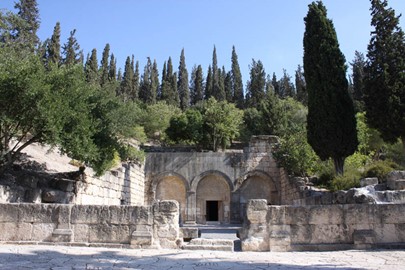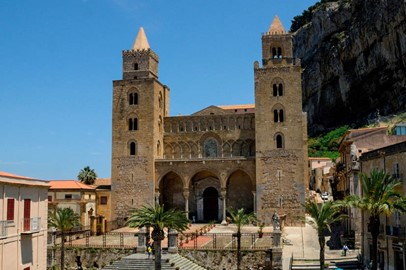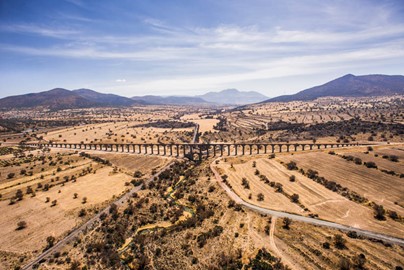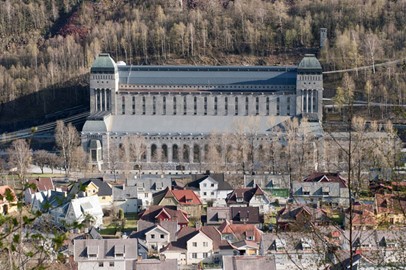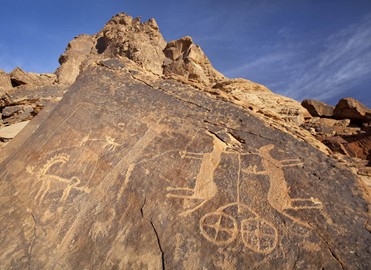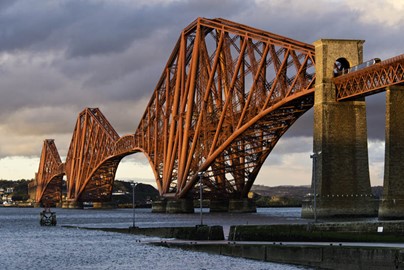search
Maymand
Maymand, a UNESCO World Heritage site in Iran, is an ancient troglodyte village renowned for its rock-carved dwellings and enduring cultural traditions. Nestled in a rugged landscape, this living heritage site features hand-dug cave homes, some inhabited for over 3,000 years, alongside seasonal settlements and traditional pastoral practices. It exemplifies human resilience and adaptation to a harsh environment, preserving a unique way of life.
Necropolis of Bet She'arim
The Necropolis of Bet She’arim, a UNESCO World Heritage site in Israel, is an ancient Jewish burial complex renowned for its elaborate rock-cut tombs and catacombs. Dating back to the 2nd century CE, it served as a major burial site following the Jewish revolt against Roman rule, featuring intricate carvings, inscriptions, and sarcophagi that reflect Jewish art and beliefs of the period. Its historical significance lies in its testament to the diaspora and resilience of Jewish culture during antiquity.
Arab Norman Palermo
Arab-Norman Palermo, a UNESCO World Heritage Site in Sicily, is a stunning testament to the cultural fusion of Arab and Norman influences in art and architecture. Its remarkable monuments, including palaces, churches, and bridges, reflect the harmonious blend of these traditions during the 12th century, showcasing a unique era of creativity and coexistence.
Blue and John Crow Mountains
The Blue and John Crow Mountains, a UNESCO World Heritage Site in Jamaica, are celebrated for their rich biodiversity and cultural significance, including their role as a refuge for the Maroons and formerly enslaved people. They symbolize the harmony between natural beauty and human resilience, preserving unique ecosystems and heritage.
Sites of Meiji Industrial Revolution
The Sites of Japan’s Meiji Industrial Revolution, a UNESCO World Heritage site, highlight the country’s rapid transformation from a feudal society to a modern industrial power in the late 19th and early 20th centuries. This collection of historic locations includes coal mines, shipyards, and steelworks, showcasing pioneering technologies and industrial heritage. Recognized for their global significance, these sites illustrate Japan’s unique blend of Western innovation and traditional craftsmanship during a ... Read More
Bethany Beyond the Jordan
Bethany Beyond the Jordan, a UNESCO World Heritage site in Jordan, is renowned as the alleged location of Jesus Christ's baptism by John the Baptist. This archaeological site features ancient churches, baptism pools, and hermit caves along the Jordan River, offering a glimpse into early Christian pilgrimage. Its well-preserved ruins and natural setting highlight its historical and spiritual significance.
Aqueduct of Padre Tembleque
The Aqueduct of Padre Tembleque, a UNESCO World Heritage site in Mexico, is a remarkable 16th-century engineering feat constructed under the direction of Franciscan friar Francisco de Tembleque. This hydraulic system, stretching nearly 48 kilometers, was designed to transport water from springs to local communities, blending Spanish and indigenous construction techniques. Its most striking feature is the series of well-preserved stone arches, with the tallest reaching over 38 meters, showcasing the architec... Read More
Burkhan Khaldun
Burkhan Khaldun, a UNESCO World Heritage site in Mongolia, is a sacred mountain revered for its spiritual and historical significance. It is deeply tied to Mongolian culture as the legendary burial place of Genghis Khan and a key site in the development of the Mongol Empire. The mountain's pristine natural environment, including forests, rivers, and diverse wildlife, reflects its role as a place of worship and pilgrimage for centuries. Its designation highlights its importance as a symbol of national identi... Read More
Rjukan Notodden
Rjukan-Notodden, a UNESCO World Heritage site in Norway, is an outstanding example of early 20th-century industrial heritage. This site showcases a well-preserved complex of hydroelectric power plants, factories, and worker settlements, illustrating the innovative use of waterpower to produce fertilizers and heavy water. The area's historical significance lies in its pioneering role in the global chemical industry and its contribution to Norway's industrial development, all set against a dramatic natural la... Read More
Baekje
The Baekje Historic Areas, a UNESCO World Heritage site in South Korea, encompass a collection of archaeological sites that showcase the rich history and culture of the Baekje Kingdom (18 BCE–660 CE). These well-preserved sites, including royal tombs, fortresses, and temples, highlight the kingdom’s sophisticated architecture, urban planning, and Buddhist influences. They also reflect Baekje’s role as a key player in East Asian cultural exchange, evident in its artistic and technological advancements. This ... Read More
Rock Art in the Hail Region
Rock Art in the Hail Region, a UNESCO World Heritage site in Saudi Arabia, features an extraordinary collection of ancient petroglyphs and inscriptions dating back thousands of years. These artworks, etched into sandstone outcrops, depict human and animal figures, hunting scenes, and symbolic motifs, offering a glimpse into the prehistoric cultures of the Arabian Peninsula. Recognized for its outstanding universal value, the site showcases the artistic and historical significance of early human expression i... Read More
Singapore Botanic Gardens
The Singapore Botanic Gardens, a UNESCO World Heritage site, is a historic tropical garden renowned for its extensive collection of plants and significant contributions to botanical research. Established in 1859, it features beautifully landscaped gardens, including the National Orchid Garden, which houses over 1,000 orchid species and 2,000 hybrids. This serene oasis serves as a vital green space, offering educational programs and conservation efforts that highlight its global importance in horticulture an... Read More
Ephesus
Ephesus, a UNESCO World Heritage site in Turkey, is an ancient city renowned for its well-preserved ruins dating back to the 10th century BC. Once a thriving Greek and Roman metropolis, it boasts iconic structures like the Temple of Artemis, one of the Seven Wonders of the Ancient World, and the grand Library of Celsus. The site also holds historical significance as a center of early Christianity, with ties to St. Paul and the Virgin Mary. Today, it stands as a testament to ancient architecture, culture, an... Read More
Diyarbakir Fortress and Hevsel Gardens
The Diyarbakır Fortress and Hevsel Gardens, a UNESCO World Heritage site in Turkey, represent a remarkable cultural landscape along the Upper Tigris River Basin. The fortress, with its imposing basalt walls and towers, has been a strategic stronghold since ancient times, reflecting the influence of Hellenistic, Roman, Byzantine, Islamic, and Ottoman civilizations. Adjacent to it, the fertile Hevsel Gardens have sustained the city with food and water for millennia, supporting a rich biodiversity, including o... Read More
Forth Bridge
The Forth Bridge, a UNESCO World Heritage Site, is an iconic railway bridge completed in 1890, renowned for its distinctive red cantilever design and engineering innovation. Spanning the Firth of Forth, it was the world’s longest single cantilever bridge at the time, stretching over 2.5 kilometers with a maximum height of 110 meters above the water. Designed by Sir John Fowler and Sir Benjamin Baker, it remains a vital transportation link and a symbol of Victorian-era industrial achievement. Its robust stee... Read More
San Antonio Missions
The San Antonio Missions, a UNESCO World Heritage site in the United States, comprise a group of five colonial-era missions established by Spanish Catholic missionaries in the 18th century. These missions, including the famous Alamo, were built to spread Christianity and Spanish culture among the indigenous populations, featuring distinctive stone churches, living quarters, and agricultural systems. Today, they stand as well-preserved historical landmarks, offering insight into the region’s colonial past an... Read More
Fray Bentos Industrial Landscape
The Fray Bentos Industrial Landscape, a UNESCO World Heritage site in Uruguay, is a historic industrial complex established in 1859 along the Uruguay River. It showcases the complete meat production process—from sourcing and processing to packing and dispatching—featuring the Liebig Extract of Meat Company’s facilities (starting in 1865) and the Anglo Meat Packing Plant (from 1924), which supplied meat extract, corned beef, and frozen meat to global markets. This site highlights the technological and cultur... Read More
Qhapaq Ñan
Qhapaq Ñan, Andean Road System, a UNESCO World Heritage site in South America, recognized in 2014, is a vast Incan road network spanning six countries—Argentina, Bolivia, Chile, Colombia, Ecuador, and Peru—built from the 13th to 16th centuries. Stretching across mountains, valleys, and deserts, this engineering marvel linked communities, facilitated trade, and supported the Inca Empire’s administration with stone paths, bridges, and rest stops. This transnational site reflects South America’s pre-Columbian ... Read More
Silk Roads Chang'an Tianshan Corridor
Silk Roads, a UNESCO World Heritage site in China, Kazakhstan, and Kyrgyzstan, recognized in 2014, is a segment of the ancient trade network linking Chang’an-Tianshan corridors, active from the 2nd century BCE to the 16th century CE. Featuring 33 sites like caravan cities, Buddhist caves, and fortifications, it reflects the exchange of goods, ideas, and cultures across deserts and mountains. This transnational site showcases Central Asia’s pivotal role in connecting East and West, preserving a legacy of his... Read More
Okavango Delta
The Okavango Delta, a UNESCO World Heritage site in Botswana, is a vast inland wetland renowned for its exceptional biodiversity and unique ecosystem. Formed by the Okavango River spreading into a labyrinth of channels, lagoons, and islands, it supports diverse wildlife, including elephants, hippos, and rare birds. Inscribed by UNESCO in 2014, it’s one of the world’s largest freshwater deltas, offering a stunning natural spectacle. The delta remains a vital haven of Botswana’s ecological heritage.
Grand Canal
The Grand Canal, a UNESCO World Heritage site in China, is an ancient engineering marvel, stretching over 1,700 kilometers as the world’s longest man-made waterway. Built starting in the 5th century BCE, it links rivers and cities, featuring locks, bridges, and historic warehouses. This vital artery of trade and culture reflects China’s ingenuity and historical connectivity.
Stone Spheres of the Diquís
The Stone Spheres of the Diquís, a UNESCO World Heritage site in Costa Rica, are a fascinating collection of pre-Columbian stone sculptures. Created by an ancient civilization, these perfectly shaped spheres, ranging in size, showcase remarkable craftsmanship and hold significant cultural and historical value, symbolizing the ingenuity and mystique of the region's past.
Stevns Klint
Stevns Klint, a UNESCO World Heritage site in Denmark, is a striking chalk cliff revealing a fossil-rich layer from the asteroid impact that ended the dinosaur era 66 million years ago. Stretching along a rugged coast, it offers a window into Earth’s geological history. This site blends scientific significance with natural beauty.
Decorated Cave of Pont d’Arc
The Decorated Cave of Pont d’Arc, a UNESCO World Heritage site in France, is a prehistoric marvel containing some of humanity’s oldest known art, dating back over 30,000 years. Discovered in 1994, its walls are adorned with vivid paintings of animals like horses, rhinos, and lions, crafted with remarkable skill. The cave’s natural archway and chambers enhance its mystique, preserving a fragile snapshot of Paleolithic life. Sealed for millennia, it offers unparalleled insight into early human creativity and ... Read More
Corvey Abbey
Corvey Abbey, a UNESCO World Heritage site in Germany, is a remarkable example of Carolingian architecture and history. Founded in 822 as a Benedictine monastery, it became a significant cultural and religious center during the Middle Ages. The abbey's well-preserved Westwerk, a monumental entrance structure, showcases intricate frescoes and is one of the few surviving examples of its kind from the 9th century. Its historical importance is further highlighted by its role in the spread of Christianity and it... Read More

